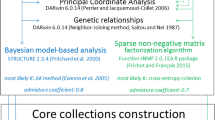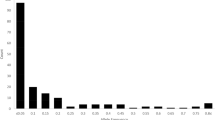Abstract
In this investigation, sampling procedures for constituting a core collection of accessions of Saccharum spontaneum germplasm collection maintained and evaluated at Sugarcane Breeding Institute, Coimbatore, India are examined. Data on a set of 21 qualitative and 10 quantitative descriptors were used to evaluate the diversity of individual characters. The overall diversity of the collection was also evaluated by pooling the Shannon Diversity Index (SDI) of the individual traits. In order to delineate a suitable core collection, stratified random sampling was attempted. For this purpose, the accessions were grouped using three different methods, namely, plant-type (habit) based grouping, multivariate cluster analysis and a grouping algorithm on the basis of an information measure. The relative efficiency of these grouping procedures was evaluated by partitioning the total diversity into between and within group diversity. The quantum of diversity (i.e. mean pooled diversity index or pooled SDI) and its sampling variance for core subsets of various sampling fractions drawn from the collection using stratified random sampling was evaluated through simulation. In general, the estimated diversity of core subsets among various methods of sampling did not differ much from the overall diversity of the base collection. Nevertheless, the sample standard deviation of the pooled SDI differed among the sample sizes and methods of allocation. Hence the optimal sample size was determined based on least sample standard deviation of the pooled SDI. In general, core subsets selected through stratified random sampling had lesser sample standard deviation of the pooled diversity index as compared to simple random sampling. Among the methods of stratification, the one based on the information measure was found to be better than plant-type based grouping or multivariate cluster analysis. A core size of 10% (about 60 accessions) drawn through stratified random sampling from the diversity groups constituted using the information measure was found to be optimum.
Similar content being viewed by others

References
Balakrishnan R. and Nair N.V. (2003). Strategies for developing core collections of sugarcane (Saccharum officinarum L.) germplasm – comparison of sampling from diversity groups constituted by three different methods. Plant Genet. Resour. Newslett. 134: 33–41
Balakrishnan R., Nair N.V. and Sreenivasan T.V. (2000). A method for establishing a core collection of Saccharum officinarum germplasm based on quantitative morphological data. Genet. Resour. Crop Evol. 47: 1–9
Balakrishnan V. and Sanghvi L.D. (1968). Distance between populations on the basis of attribute data. Biometrics 24: 859–865
Berding N. and Roach B.T. (1987). Germplasm collection, maintenance and use. In: Heinz, D.J. (eds) Sugarcane Improvement through Breeding, pp 143–210. Elsevier, New York
Bisht I.S., Mahajan R.K., Loknathan T.R. and Agrawal R.C. (1998). Diversity in Indian sesame collection and stratification of germplasm accessions in different diversity groups. Genet. Resour. Crop Evol. 45: 325–335
Brown A.H.D. (1989). Core collections: a practical approach to genetic resources management. Genome 31: 818–824
Brown A.H.D. and Spillane C. (1999). Implementing core collections – principles, procedures, progress, problems and promise. In: Johnson, R.C. and Hodgkin, T. (eds) Core Collections for Today and Tomorrow, pp 1–9. IPGRI, Rome
Crossa J., DeLacy I.H. and Taba S. (1995). The use of multivariate methods in developing a core collection. In: Hodgkin, T., Brown, A.H.D., Hintum, Th.J.L.van, and Morales, E.A.V. (eds) Core Collections of Plant Genetic Resources, pp 77–92. Wiley, New York
Frankel O.H. (1984). Genetic perspectives of germplasm conservation. In: Arber, W., Llimensee, K., Peacock, W.J. and Starlinger, P. (eds) Genetic Manipulation: Impact on Man and Society, pp 161–170. Cambridge University Press, Cambridge
Frankel O.H. and Brown A.H.D. (1984). Plant genetic resources today: a critical appraisal. In: Holden, J.H.W. and Williams, J.T. (eds) Crop Genetic Resources: Conservation and Evaluation, pp 249–268. Allen and Unwin, Winchester, MA
Harch B.D., Basford K.E., DeLacy I.H., Lawrence P.K. and Cruickshank A. (1996). Mixed data types and the use of pattern analysis on the Australian groundnut germplasm data. Genet. Resour. Crop Evol. 43: 363–376
Hintum Th.J.L. van. (1994). Hierarchical approaches to the analysis of genetic diversity in crop plants. In: Hodgkin, T., Brown, A.H.D., Hintum, Th.J.L.van and Morales, E.A.V. (eds) Core Collections of Plant Genetic Resources, pp 23–34. John Wiley & Sons, Chichester, U.K.
Hintum Th.J.L. van,, Brown A.H.D., Spillane C. and Hodgkin T. (2000). Core Collections of Plant Genetic Resources. International Plant Genetic Resources Institute, Rome, 6–42.
Kandasami P.A., Sreenivasan T.V., Rao T.C.R., Palanichami K., Natarajan B.V., Alexander K.C., Rao M.M. and Mohanraj D. (1983). Sugarcane Breeding Institute, Coimbatore, India
Mahajan R.K., Bisht I.S., Agrawal R.C. and Rana R.S. (1996). Studies on South Asian Okra collection: methodology for establishment a representing core set using characterization data. Genet. Resour. Crop Evol. 43: 249–255
Mukherjee S.K. (1957). Bot. Gaz. 199: 55–61
Noirot M., Hamon S. and Anthony F. (1996). The principal component scoring: a new method of constituting a core collection using quantitative data. Genet. Resour. Crop Evol. 43: 1–6
Peeters J.P. and Martinelli J.A. (1989). Hierarchical cluster analysis as a tool to manage variation in germplasm collections. Theor. Appl. Genet. 78: 42–48
Poole R.W. (1974). An Introduction to Quantitative Ecology. McGraw Hill, Tokyo
Rao C.R. (1952). Advanced Statistical Methods in Biometric Research. John Wiley & Sons, New York
Roach B.T. (1972). Nobilisation of sugarcane. Proc. Int. Soc. Sugarcane Tech. 14: 206–216
Roach B.T. (1978). Utilisation of Saccharum spontaneum in sugarcane breeding. Proc. Int. Soc. Sugarcane Tech. 16: 43–58
Roach B.T. (1984). Conservation and use of the genetic resources of sugarcane. Sugar Cane 2: 7–11
Roach B.T. (1995). Case for a core collection of sugarcane germplasm. Proc. Int. Soc. Sugarcane Tech. 21: 339–350
Roach B.T. and Daniels J. (1987). A Review on the Origin and Improvement of Sugarcane. Proc. Copersucar Intern. Sugarcane Breeding Workshop, Brazil, 1–32
Spagnoletti Zeuli P.L. and Qualset C.O. (1993). Evaluation of five strategies for obtaining a core set from a large genetic resource collection of durum wheat. Theor. Appl. Genet. 87: 295–304
Sreenivasan T.V., Amalraj V.A. and Jebadhas A.W. (2001). Sugarcane genetic resources: Saccharum spontaneum – Vol. 2. Sugarcane Breeding Institute, Coimbatore, India
Tai P.Y.P. and Miller J.D. (2001). A core collection for Saccharum spontaneum L. from the World Collection of sugarcane. Crop Sci. 41(3): 879–885
Tai P.Y.P., Miller J.D. and Legendre B.L. (1994). Preservation of Saccharum spontaneum germplasm through storage of true seed. Sugar Cane 6: 3–8
Tai P.Y.P., Miller J.D. and Legendre B.L. (1995). Evaluation of the world collection of Saccharum spontaneum L. Proc. Int. Soc. Sugarcane Technol. 21: 250–260
Tai P.Y.P., Miller J.D. and Legendre B.L. (1999). Preservation of Saccharum spontaneum germplasm in the world collection of sugarcane and related grasses through storage of true seed. Sugar Cane Issue no. 3: 4–10
Walker D.I.T. (1972). Utilisation of noble and Saccharum spontaneum germplasm in the West Indies. Proc. Int. Soc. Sugarcane Technol. 14: 224–232
Author information
Authors and Affiliations
Corresponding author
Rights and permissions
About this article
Cite this article
Amalraj, V.A., Balakrishnan, R., Jebadhas, A.W. et al. Constituting a Core Collection of Saccharum spontaneum L. and Comparison of Three Stratified Random Sampling Procedures. Genet Resour Crop Evol 53, 1563–1572 (2006). https://doi.org/10.1007/s10722-005-8510-5
Received:
Accepted:
Published:
Issue Date:
DOI: https://doi.org/10.1007/s10722-005-8510-5



